
Indian Prime Minister Narendra Modi launched e-RUPI, a cashless and contactless instrument for digital payments. e-RUPI is a digital currency. It is perfect for contactless and cashless digital payments. Funds will be delivered to mobile phones via a QR code or an SMS string. Read to know more about it.
What is e-RUPI?

e-RUPI is the new mode of digital payments based on electronic vouchers. The platform is secure and developed by the National Payments Corporation of India (NPCI). Prime Minister, Narendra Modi launched the new digital currency on Monday. This new format is a purpose-specific and person-specific payment system. The cashless and contactless payment system can be revolutionary in the post COVID-19 era.
How does e-RUPI work?

The payment will work akin to a prepaid gift voucher. You can redeem it at specific centers without using your debit card, credit card, or internet banking. Moreover, it will also connect sponsors with service providers and beneficiaries. It is also made entirely digitally and does not have physical involvement. The e-RUPI payments will deliver to the beneficiary’s mobile phone as a QR code or an SMS string. Moreover, the beneficiary identification is through their mobile numbers and a voucher designated by their bank to service providers.
How is it different from a digital currency?

The Indian government is working towards the development of a central bank digital currency (CBDC) system. The launch of e-RUPI can locate gaps in the current system and act as a benchmark for future payment systems. Additionally, e-RUPI has the backing of the Indian rupee. Moreover, it acts as a virtual payment system with vouchers. “They are desirable not just for the benefits they create in payments systems. But also might be necessary to protect the general public in an environment of volatile private VCs,” said T Rabi Sankar, the deputy governor of RBI.
Additionally, the BIS Annual report mentions that “The central banks have a duty to safeguard people’s trust in our money. So, Central banks must complement their domestic efforts with close cooperation. It is to guide the exploration of central bank digital currencies to identify reliable principles and encourage innovation.”






